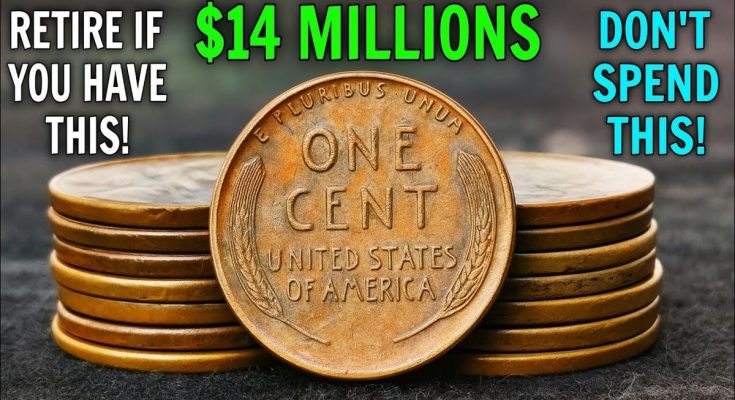💰 The Penny That Could Make You a Millionaire! Uncovering the World’s Rarest Wheat Cents
Headline: You Won’t Believe These 10 Rare Wheat Pennies Worth Millions! Rare & Valuable Old Coins To Look For.
Description:
Could a single penny be worth a fortune? The image you see—featuring the iconic Lincoln Wheat Cent—isn’t a fantasy. It’s a challenge to every coin collector, history enthusiast, and casual treasure hunter: the key to an unexpected retirement might be hiding in your old change jar!
The Lincoln Wheat Cent, minted from 1909 to 1958, is a beloved piece of American history. Its reverse, featuring two stalks of wheat framing the inscription “ONE CENT,” is a nostalgic symbol for many. While most of the billions minted are worth just a few cents, a small handful—born from historical circumstance or minting error—have become some of the most valuable and sought-after coins in numismatic history. We’re diving deep into the world of these “Million Dollar Pennies” to reveal the exact rare and valuable old coins you need to be looking for.
🔍 The Secret of the Fortune Penny: Errors and Key Dates
What turns a humble one-cent coin into a monumental treasure? It comes down to three factors: Minting Errors, Key Dates (Low Mintage), and Condition. The most valuable pieces are often those where the U.S. Mint made a mistake, creating a tiny pool of accidental rarities.
Here are some of the legendary Wheat Pennies that have sold for eye-watering prices:
- The 1943 Bronze (or Copper) Cent: This is arguably the “Holy Grail” of all Wheat Pennies. During World War II, copper was vital for the war effort, so the Mint switched to zinc-coated steel for pennies in 1943. However, a few bronze planchets were accidentally struck with the 1943 die. Only about a dozen are known to exist. One 1943-D Bronze Cent sold for a staggering $840,000 at auction! Finding one of these is the ultimate numismatic dream.
- The 1944 Steel Cent: The reverse of the 1943 error—in 1944, the Mint returned to copper, but a small number of steel planchets from the previous year were mistakenly struck. These incredibly rare transitional errors can sell for hundreds of thousands of dollars, with one 1944-S Steel Cent fetching $408,000.
- The 1955 Doubled Die Obverse (DDO): This is one of the most famous and recognizable errors. A misalignment during the die striking process resulted in a dramatic doubling of the date (“1955”) and the lettering on the obverse. While not a million-dollar coin, high-grade examples have sold for over $100,000, and finding one in circulation is still a life-changing discovery for a collector.
- The 1909-S VDB: The very first year of the Lincoln Cent, the “VDB” stands for Victor David Brenner, the coin’s designer, whose initials were placed prominently on the reverse. Public outcry led to the rapid removal of the initials, making the coins minted in San Francisco with the initials extremely rare. With a low mintage of just 484,000, high-grade examples can command prices well over $100,000.
🧐 Your Treasure Hunting Checklist: Look For These 10 Rarities
While the million-dollar errors are the stuff of legend, many other key dates and varieties can bring in thousands of dollars. Keep your eyes peeled for these valuable Wheat Cents:
- 1943 Bronze/Copper Cent (The Ultimate Error)
- 1944 Steel Cent (The Follow-Up Error)
- 1955 Doubled Die Obverse (The King of Doubled Dies)
- 1909-S VDB (The Iconic First-Year Rarity)
- 1914-D (Key Date with Extremely Low Mintage)
- 1931-S (A Depression-Era Rarity)
- 1922 “No D” (The Mint Mark Mystery)
- 1917 Doubled Die (Visible Doubling on the Date)
- 1914-S (A Highly Sought-After Semi-Key)
- 1958 Doubled Die Obverse (The Final Error Legend)
💡 A Word of Caution: Don’t Spend This!
The sensational text on the image—”DON’T SPEND THIS!”—is a crucial piece of advice. If you think you’ve found a rare variety, never attempt to clean the coin. Cleaning can permanently damage its surfaces and destroy its numismatic value. Consult with a professional coin grading service to authenticate and grade your potential treasure.
Whether you’re new to coin collecting or a seasoned numismatist, the thrill of the hunt for these rare and valuable Wheat Pennies remains one of the hobby’s greatest excitements. Check your old albums, coin rolls, and family heirlooms—that unassuming one-cent piece might just be your ticket to a fortune!
Would you like me to provide a step-by-step guide on how to safely inspect a Wheat Penny for the famous 1943 Copper error?



